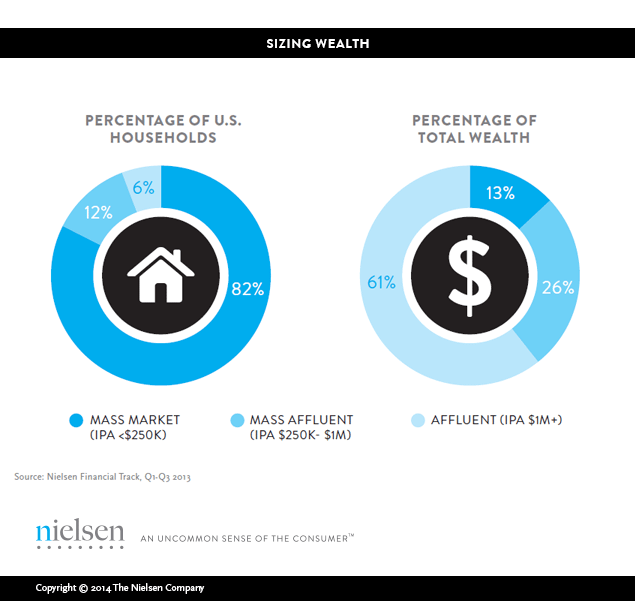While consumers look for bang for their shopping bucks, companies seek bang for their advertising bucks. And for the biggest bang, marketers should seek consumers with the strongest spending power. Fitting this bill, the “mass affluent” are wealthier than the average Joe and control 26 percent of total wealth in the U.S.
However, this group represents just 12 percent of U.S. households, making them notoriously difficult to find and engage through traditional direct marketing channels. But their active online presence presents an intriguing opportunity for marketers to use digital precision marketing to reach this elusive audience while protecting their privacy.
Income Doesn’t Necessarily Mean Wealth
Despite the recent recession, mass affluent consumers have between $250,000 and $1,000,000 in liquid assets, excluding real estate. While the economy is showing positive signs of recovery, this level of wealth is well above the U.S. average. In 2013, U.S. consumer’s median wealth was $17,050, up from $14,450 the year before. So what makes the mass affluent worth so much?
Nielsen Income Producing Assets (IPAs) include the value of checking accounts, savings products, money market accounts and CDs, investment products, retirement accounts, and other asset types that are relatively easy to liquidate, and do not include any real estate owned by the household. Nielsen measures consumer IPAs as an important indicator of liquid wealth. Other measures like age and income do not give us as refined view of the population. High household income does not necessarily indicate high wealth and thus greater ability to spend. Among those with over $100,000 household income, only about half have liquid assets (excluding real estate) that exceed $100,000. Wealth, on the other hand, represents financial stability within the household and is a truer measure of the ability and confidence to spend than income alone, especially on big-ticket items like cars, homes and luxury goods.

The Mass Affluent’s Digital Worth
The mass affluent spend much of their time online, and understanding their digital behavior is vital to understanding how to engage with these key consumers. Working mass affluent are 40 percent more likely than the average consumer to monitor their investments and stocks online, while those who are retired are 84 percent more likely than the average consumer. In addition to keeping tabs on their finances, these consumers are more likely than the average person to visit websites that reflect their interest in sports, home, travel and food. And they’re not just visiting these sites; they’re making online purchases related to these interests. The mass affluent purchase sporting goods, as well as appliances and housewares, online at a higher rate than the average consumer.
Despite being tech-savvy and comfortable using technology, the mass affluent are disproportionately concerned about Internet privacy and security, using spyware and antivirus software to keep their computers and private information safe.
Influencing the Affluent Online
Since the mass affluent are such a small portion of the U.S. population, broad sweeping marketing efforts are not efficient to reach this audience. Precision marketing provides a more accurate means of finding and reaching these likely big-ticket spenders through their favorite medium—the Internet.
Digital precision marketing can be done easily and accurately via cookie technology. Consumers can be tagged for wealth metrics like IPA, significantly increasing the likelihood of reaching the intended audience. So instead of only focusing on the mass affluent who have visited a particular website, the entire wealthy population can be found and reached online with display advertising, online video and mobile.
And importantly given the mass affluent’s concerns with online security, this form of marketing protects privacy while providing a 360-degree view of the consumer. Such segmentation preserves privacy because only segment assignments are stored rather than personal information. At the same time, digital precision marketing’s success can still be measured throughout the consumer purchase journey. The impact can be quantified by tracking consumer awareness through direct response metrics like click-throughs, understanding online intent and capturing impact on retail sales.




